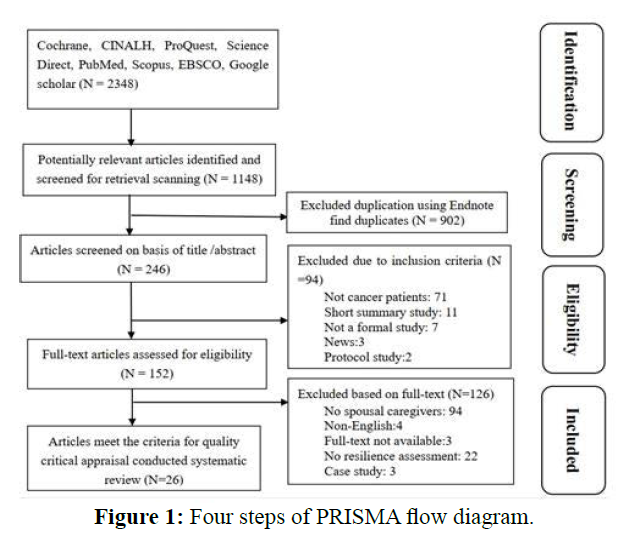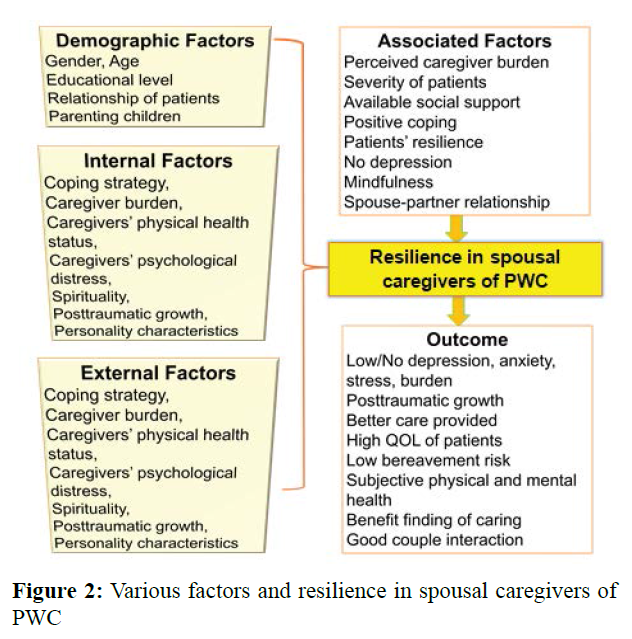Sun Haiyan*
Department of Nursing, Faculty of Nursing, Burapha University, Chon Buri, Thailand
- *Corresponding Author:
- Sun Haiyan
Ph.D. student, Department of Nursing, Faculty of Nursing, Burapha University, Chon Buri, Thailand
E-mail: Haiyan_s@gmail.com
Received Date: October 07, 2021; Accepted Date: October 22, 2021; Published Date: October 29, 2021
Introduction
Cancer is among the leading causes of morbidity and mortality worldwide and marks a critical life event for the entire family that can cause distress and significant challenges for all involved. Proverbially, cancer impacts not only those diagnosed but also families, especially those spouses who are often the primary caregivers of these patients. Resilience is the ability of individuals to adapt well in the face of adversity [1]. Resilience and its associated factors among spousal caregivers were reviewed and synthesized to obtain better understanding and guidance for further research regarding this phenomenon [2].
Purpose: To explore resilience, and identify the measurement used to assess resilience and associated factors in spousal caregivers of patients with cancer (PWC).
Methods: A literature review was performed using electronic database across Cochrane, CINALH, ProQuest, Science Direct, PubMed, Scopus, EBSCO, Google scholar. The articles were published in English with full text from January 2010 to January 2020.
The key terms used to search as follows;
Inclusion criteria:
1. Resilience in spousal caregivers for cancer patients who were alive;
2. Resilience by using resilience scales or measure resilience by using related variables that reflects resilience which were clearly mentioned in the articles;
3. Spousal caregivers’ age more than 18-year-old (Figure 1);
Figure 1: Four steps of PRISMA flow diagram.
4. Quantitative, qualitative, and mixed-method research;
5. Articles which met the above eligible criteria were included in this review if it was possible to extract the findings.
Results
• According to data retrieval, 26 articles were finally selected including 17 quantitative researches, 6 qualitative researches, and 3 mixed-method researches (Figure 2).
Figure 2: Various factors and resilience in spousal caregivers of PWC
• Resilience in spousal caregivers of PWC showed an ability to adapt and deal with the challenges of caring for their lovers, which would be those with female gender, younger age, better education, and no child-rearing burden. But other demographic characteristics such as ethnicity, occupation, work status were not associated with resilience [3-5].
• Two types of measurement in resilience were explored across 26 studies. Resilience was measured by using exact resilience scales (i.e. Connor-Davidson or Wagnild Resilience Scales) or using other variables to indicate either more positive psychological outcome such as coping and adaptation or less negative psychological outcome such as lower depression and stress etc. (Table 1).
| String 1 |
resilience or resiliency or resilient |
| String2 |
“spousal caregiver” or “family caregiver” or
“carer” or “spouses” or “partner” or “partners” |
| String 3 |
cancer or malignancy or malignant tumor or
malignant or oncology |
| Final search |
(resilience or resiliency or resilient) AND (“spousal caregiver” or “family caregiver” or “carer” or “spouses” or “partner” or “partners”) AND (cancer or malignancy or malignant tumor or malignant or oncology) |
Table 1: Strings and their description.
• For factors associated with resilience, these can be classified as individual internal and external factors. Internal factors include caregiver burden, psychological distress, coping strategies etc., whereas social support, couple interaction, patients’ health status etc. are external factors.
Conclusions
The current findings add to our understanding of resilience as a distinct trajectory of adjustment and provide further knowledge on the resilience associated factors. Caring for patients with cancer can be a form of stress and affected spousal caregivers’ health and well-being. Resilience plays an important role in promoting positive adaptation in spite of adversity among the spousal caregivers of cancer patients. With the uniqueness of resilience among these caregivers, ways to assess resilience and identify its associated factors deserve more attention and careful consideration.
References
- Bookwala J (2014) Spouse health status, depressed affect and resilience in mid and late life: a longitudinal study. Dev Psychol 50:1241-9.
- Hwang IC, Kim YS, Lee YJ, Choi YS, Hwang SW, et al. (2018) Factors Associated With Caregivers' Resilience in a Terminal Cancer Care Setting. Am J Hosp Palliat Care 35:677-83.
- Wagnild G (2009) A review of the Resilience Scale. J Nurs Measurement 17:105-13.
- Charlene JT, Olinda S, Gillian P, Helen C, Chris RC, et al. (2019) Psychosocial interventions for informal caregivers of people living with cancer. Cochrane Database Syst Rev 6:CD009912.
- Haiyan S, Yang Q, Pornpat H (2021) Factors associated with resilience in spousal caregivers of patients with cancer: An integrative review. Nurs Open 8:2131-41.



